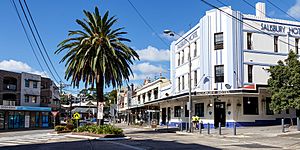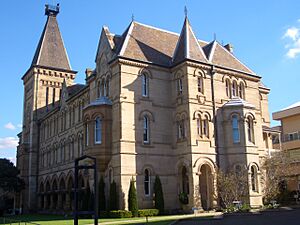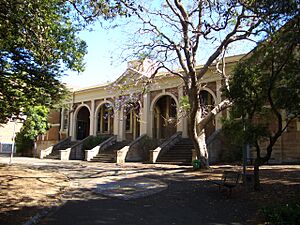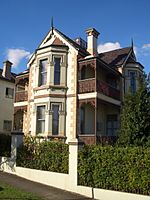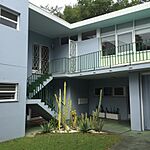Stanmore, New South Wales facts for kids
Quick facts for kids StanmoreSydney, New South Wales |
|||||||||||||||
|---|---|---|---|---|---|---|---|---|---|---|---|---|---|---|---|

Aerial view of the suburb
|
|||||||||||||||
| Postcode(s) | 2048 | ||||||||||||||
| Elevation | 38 m (125 ft) | ||||||||||||||
| Area | 2.0 km2 (0.8 sq mi) | ||||||||||||||
| Location | 6 km (4 mi) south west of Sydney CBD | ||||||||||||||
| LGA(s) | Inner West Council | ||||||||||||||
| State electorate(s) | Newtown | ||||||||||||||
| Federal Division(s) | Grayndler | ||||||||||||||
|
|||||||||||||||
Stanmore is a suburb located in the Inner West area of Sydney, New South Wales, Australia. It is about 6 kilometres south-west of the main city centre of Sydney. Stanmore is part of the Inner West Council, which is the local government body for the area. It is well-known for its long street of shops along Parramatta Road, which is also called the Great Western Highway.
Contents
History of Stanmore
Before British settlers arrived, the land where Stanmore now stands was home to the Gadigal people. They are part of the larger Eora Nation of coastal Aboriginal peoples. The first pieces of land in this area were given to British officers by Governor Arthur Phillip between 1793 and 1810.
How Stanmore Got Its Name
Stanmore was named by a man called John Jones. He was a saddler, which is someone who makes and repairs saddles. In 1835, John Jones settled on the land where Newington College is today. He called his property the Stanmore Estate. He chose this name because it was the same as his birthplace, Stanmore, which is now a suburb in north-west London.
Early Development and Changes
An important road, Stanmore Road, was built in 1835. This helped the area start to grow. In 1855, a railway line was built. This line split Stanmore into different parts. North and West Kingston were north of the railway, and South Kingston was south of it.
Over time, the name Stanmore became more common. It slowly replaced the older name, Kingston. In 1878, the Stanmore railway station opened. This led to more buildings and homes being built, especially west of Percival Road. Stanmore became a popular place to live in the 1880s and 1890s. This was helped by the opening of Newington College and new shops on Percival Road. Many streets were named after English colonies, showing the English culture of the time.
Modern Stanmore
In the early 1920s, some small factories opened near Parramatta Road. These included a chocolate maker and a cordial company. Both of these have now closed. Their old buildings have been turned into offices and apartments. Today, Stanmore is known as a green suburb with many old, grand homes. These houses are often built in a style called High Victorian Italianate.
Heritage-Listed Places
Stanmore has several places that are important for their history and are protected. These include:
- 37 Cavendish Street: The New South Wales Aboriginal Education Consultative Group Office.
- 125 Corunna Road: The Corunna Road Sewer Vent and Cottage.
- Great Southern and Western railway: The Stanmore railway station.
Population of Stanmore
According to the 2021 census, Stanmore had 7,619 people living there. Most people, about 68.3%, were born in Australia. Other common birthplaces included England (4.6%), New Zealand (2.1%), and Portugal (1.4%).
When asked about religion, most people (54.0%) said they had no religion. Other common responses were Catholic (18.9%) and Anglican (6.0%). About 76% of homes in Stanmore spoke only English. However, about 25.4% of homes spoke other languages. The most common languages spoken at home, besides English, were Greek, Spanish, and Italian.
Shops and Getting Around
Stanmore railway station is part of the Sydney Trains network. It is on the Inner West & Leppington Line. Stanmore has a small group of shops right next to the railway station. There are also many shops and businesses along Parramatta Road.
Schools in Stanmore
Stanmore is home to several schools:
- Newington College: This is an independent boys' school. It is part of the GPS group of schools.
- Stanmore Public School: This is a public primary school.
- Saint Michael's Catholic Primary School Stanmore: This is a Catholic primary school.
Both Newington College and Stanmore Public School have important historical buildings. Their main buildings have very special designs. An expert on architecture, Morton Herman, said that Newington's 1881 building is a great example of Gothic Revival style for schools. He also said that Stanmore Public School's design is a "pleasant" example of simple classicism.
Sports and Fun
Stanmore has a few small parks and playgrounds for sports and recreation. These include Weekley Park, Crammond Park, and Montague Gardens. Stanmore also gives its name to the Stanmore Hawks soccer club. This team plays in the NSW State League Division One, which is a high level of soccer in Sydney.
Churches
Churches in Stanmore include St Michael The Archangel Catholic Church and Stanmore Baptist Church.
Famous People From Stanmore
Many interesting people have lived in or come from Stanmore. Here are a few:
- Sid Barnes (1916–1973): A famous Test cricketer.
- Sir Garfield Barwick (1903–1997): He was the 7th Chief Justice of Australia, which is the top judge in the country. He grew up in Stanmore.
- Noelene Brown OAM (born 1938): An actress and comedian who lived in Stanmore and went to Stanmore Public School.
- Harold Holt (1908–1967): He was the 17th Prime Minister of Australia. He was born in Stanmore.
- Leigh Sales (born 1973): A well-known journalist for ABC.


